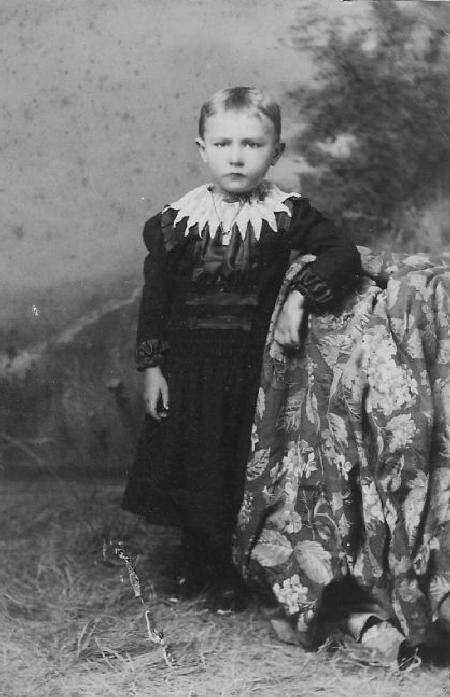
American Boy Dresses: Styles--Collars

Figure 1.--This cabinent card is undated. Note the multi-pointed pin-on lace collar. The dress itself does not seem to have a collar, the lace collar sems to be pinned on. We would guess thatt the portrait was taken in the 1880s. The portrait was taken in Phillipsburg, New Jersey. Also note the locket. A reader writes, "I think it is useful to estimate the ages in these images. The boy appears to me to be 5 or 6 years old. His face does not have enough baby fat to be younger." Well estimate ages is tricky. I would say that he is a bit younger, probably about 4 years old. His height in comparison to the table is a useful clue here.
|
|
We notice a wide range of collars worn with dresses. We notice dresses with and without collars. Some dresses did not have collars while others had very large, fancy ones. Many dresses in the early- and mid-19th century not only did not have collars, but had low necklines. These had disappeared by the late-19th century. The collars we note included both both small inconspicuous coolars and large fancy ones. They were done in many different designs shapes and styles. Here there were similarities with collars on shirts and blouses. Many collars were done in the same color and material as the dress. Others contrasted with the dress. While collars were worn, but not the most common as opposed to the shirts and blouses boys wore. The collars varied greatly in size and style. Most dresses had colars that were a part of the dress. There were also pin-on and other detachable collars. A popular type of pin-on collar was the lace collar. We also see Eton collars. One popular style was lace collars. We see them in different shapes and sizes. We also note Eton collars, Peter Pan collars, ruffled collars and ruffs, and many other styles. Both boys an girls wore dresses with lace collars. We note an unidentfied boy wearing a ruffled collar with his dress in the 1850s. We notice Willie Blatt with a very small ruff during the 1870s. These ruffs do not seem to be part pf the dress, but rather on a garment worn under the dress.
Basic Neck Options
We notice a wide range of collars worn with dresses. Dress mak,ers had two basic options as to how to treat the neck. We notice dresses with and without collars. Some dresses did not have collars while others had very large, fancy ones. Many dresses in the early- and mid-19th century not only did not have collars, but had low necklines. These wee very common for girls as well as younger boys. These began to disappear after mid-century, especially by the late-19th century. The collars we note included both both small inconspicuous coolars and large fancy ones. The one constant was that the neckline was now at the neck, buth both with and without collars. And in some cases there was a kind of blkend, meaning the dress itself did not have a collar, but on might be pinned on. The lace collar the biy here is wearing is a good example (figure 1).
They were done in many different designs shapes and styles. Here there were similarities with collars on shirts and blouses. Many collars were done in the same color and material as the dress. Others contrasted with the dress. While collars were worn, but not the most common as opposed to the shirts and blouses boys wore. The collars varied greatly in size and style. Most dresses had colars that were a part of the dress. There were also pin-on and other detachable collars. A popular type of pin-on collar was the lace collar. We also see Eton collars. One popular style was lace collars. We see them in different shapes and sizes. We also note Eton collars, Peter Pan collars, ruffled collars and ruffs, and many other styles. Both boys an girls wore dresses with lace collars. We note an unidentfied boy wearing a ruffled collar with his dress in the 1850s. We notice Willie Blatt with a very small ruff during the 1870s. These ruffs do not seem to be part pf the dress, but rather on a garment worn under the dress.
Chronology
We do not much information on collar treatment in the early-19th century, although there are some available painted portraits. With the development of photography we have increasing number of images. Early formsts, Daguerreotypes (1840s) and later Ambrotypes (1850s) often cut off the subject at about the waist mean they often are not helpful for many garments or parts of garments, but for collars they provide a wealth of information. And with the appearance of CDVs, huge nimbers of images bcome available (1860s).
HBC

Navigate the Historic Boys' Clothing Web dress pages:
[Return to the Main U.S. dress elenent page]
[Return to the Main U.S. national dress/kilt style page]
[Return to the Main U.S. national dress style page]
[Pinafores]
[Ringlet curls]
[Smocks]
[Bodice kilts]
[Kilts]
[Fauntleroy dresses]
[Sailor dresses]
[Fancy dresses]
[Dresses: 16th-18th centuries]
[Dresses: Early-Mid-19th century]
[Dresses: Late-19th century]
[Dresses: Early 20th century]
[Difficult images]
[Movie dresses]
Navigate the Boys' Historical Clothing Web Site:
[Introduction]
[Activities]
[Biographies]
[Chronology]
[Clothing styles]
[Countries]
[Bibliographies]
[Contributions]
[Essays]
[FAQs]
[Glossaries]
[Images]
[Links]
[Registration]
[Tools]
[Boys' Clothing Home]
Created: 4:07 AM 12/1/2007
Last updated: 2:08 AM 11/26/2014



